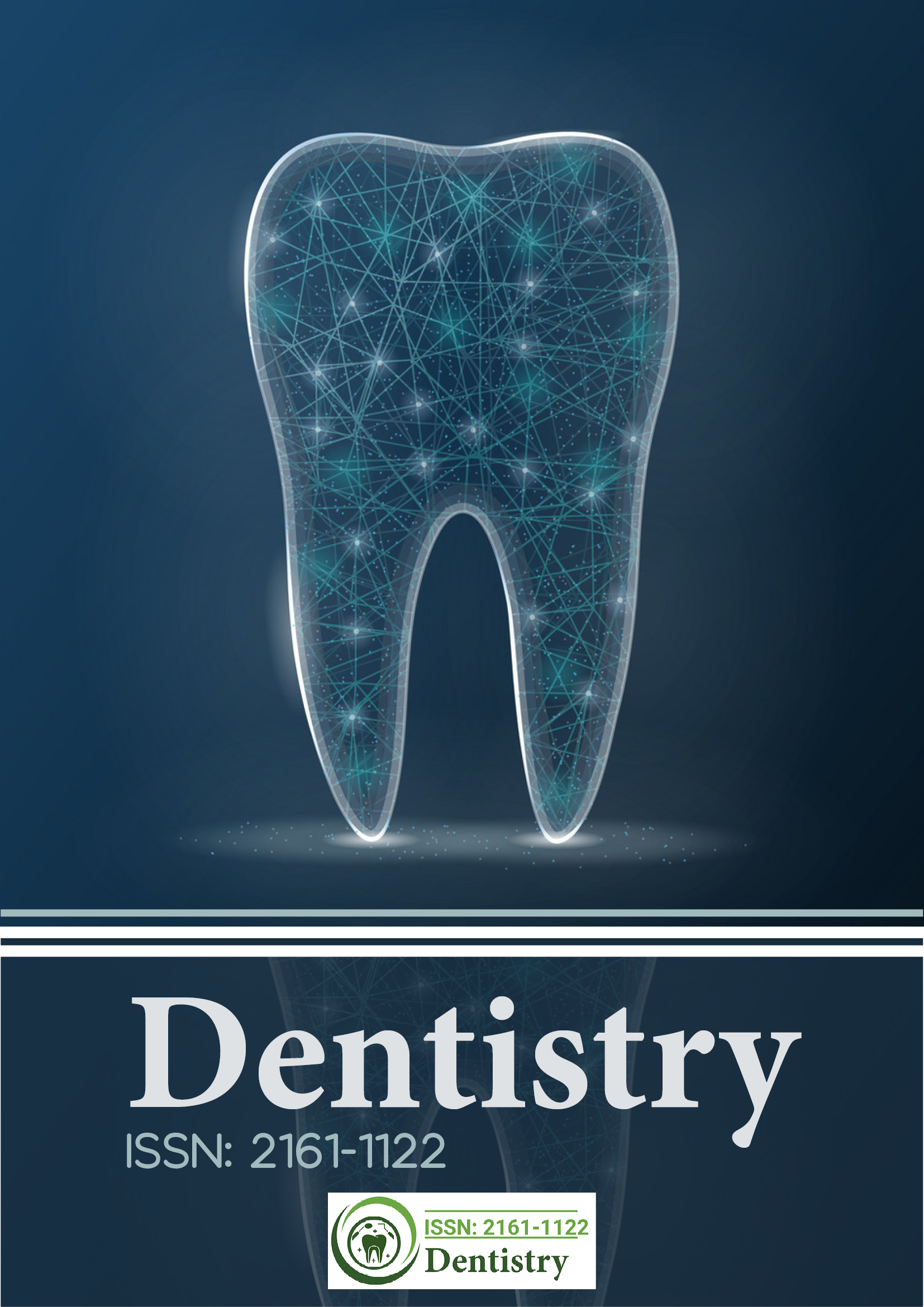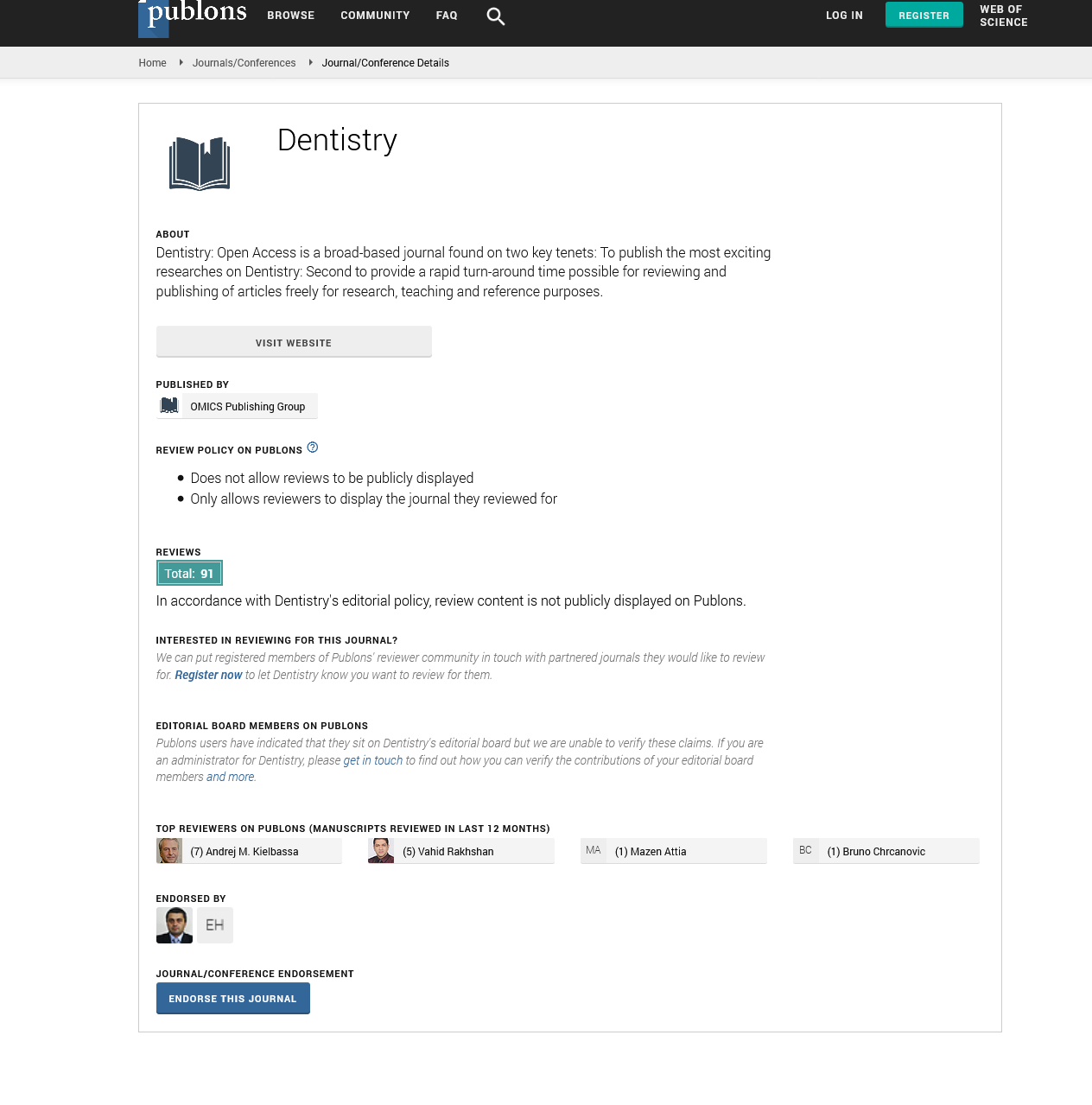Citations : 2345
Dentistry received 2345 citations as per Google Scholar report
Indexed In
- Genamics JournalSeek
- JournalTOCs
- CiteFactor
- Ulrich's Periodicals Directory
- RefSeek
- Hamdard University
- EBSCO A-Z
- Directory of Abstract Indexing for Journals
- OCLC- WorldCat
- Publons
- Geneva Foundation for Medical Education and Research
- Euro Pub
- Google Scholar
Useful Links
Share This Page
Journal Flyer

Open Access Journals
- Agri and Aquaculture
- Biochemistry
- Bioinformatics & Systems Biology
- Business & Management
- Chemistry
- Clinical Sciences
- Engineering
- Food & Nutrition
- General Science
- Genetics & Molecular Biology
- Immunology & Microbiology
- Medical Sciences
- Neuroscience & Psychology
- Nursing & Health Care
- Pharmaceutical Sciences
Short Communication - (2025) Volume 15, Issue 2
Trends and Future Directions in Literature of Dentistry Oral Surgery and Medicine
Gemma Parke*Received: 26-May-2025, Manuscript No. DCR-25-29698; Editor assigned: 28-May-2025, Pre QC No. DCR-25-29698 (PQ); Reviewed: 11-Jun-2025, QC No. DCR-25-29698; Revised: 18-Jun-2025, Manuscript No. DCR-25-29698 (R); Published: 25-Jun-2025, DOI: 10.35248/2161-1122.25.15.724
Description
Teledentistry has emerged as a transformative approach in dental practice, offering remote consultation, diagnosis and follow-up through digital platforms. Its integration into dentistry, oral surgery and medicine has accelerated in recent years, especially with the growing emphasis on digital health solutions. Bibliometric analysis provides a systematic method to assess research progress, collaboration networks and thematic evolution of this field. This article presents a bibliometric evaluation of teledentistry literature published within the category of dentistry, oral surgery and medicine, examining publication trends, leading countries, institutions, journals, authorship patterns and thematic clusters.
The rapid evolution of digital technology has influenced healthcare delivery across disciplines and dentistry is no exception. Teledentistry, a subset of telemedicine, involves the use of information and communication technologies for dental care, education and research. Its applications include remote consultations, screening, patient monitoring, continuing dental education and access to specialized services for underserved populations.
Growth of teledentistry publications
The earliest studies on teledentistry date back to the late 1990s, primarily focused on feasibility and pilot testing of telecommunication in dental care. Publication activity remained relatively low until the early 2010s, when the proliferation of smartphones and improved internet connectivity made digital consultation more practical.
A major surge in publications occurred after 2020 due to the COVID-19 pandemic. Restrictions on physical consultations forced both practitioners and patients to explore virtual platforms, resulting in a sharp rise in research articles, case reports and reviews on teledentistry applications. Studies during this period highlighted its role in maintaining continuity of care, triaging emergencies, delivering remote orthodontic follow-ups and ensuring patient safety [1,3].
Leading countries and institutional contributions
The United States, India, the United Kingdom, Brazil and Australia emerge as the top contributors in teledentistry literature. The U.S. has been a pioneer in adopting telehealth policies, which translated into high research productivity. India demonstrated considerable growth, reflecting the interest in extending dental care access to rural and underserved regions. Institutions such as King’s College London, Harvard University and the University of São Paulo appear frequently in bibliometric datasets. Collaborative networks show partnerships between developed and developing countries, although collaborations remain largely regional [4,7].
Impact of COVID-19 on teledentistry research
The pandemic acted as a catalyst, significantly accelerating both adoption and research. Studies published between 2020 and 2022 account for a large proportion of total citations in the field. Research during this phase emphasized practicality, patient acceptance, regulatory frameworks and data security. Long-term bibliometric analysis reveals that while COVID-19 sparked a surge, teledentistry research continues to evolve beyond the pandemic. Current studies are investigating cost-effectiveness, integration into healthcare systems and patient satisfaction over extended use.
Citation analysis and influential articles
Highly cited articles in teledentistry often focus on its feasibility, role in public health and its rapid uptake during global health crises. Systematic reviews and meta-analyses examining teleconsultation effectiveness attract significant citations. Influential case studies highlight successful models of implementation in orthodontics, oral surgery follow-ups and remote monitoring of oral lesions.
Dentistry, oral surgery and medicine
The bibliometric profile demonstrates that teledentistry is no longer viewed as an auxiliary practice but as an integral component of oral healthcare delivery. In dentistry, it supports preventive care and orthodontic monitoring. In oral surgery, it facilitates pre-operative consultations and post-operative follow-ups. Within medicine, it contributes to multidisciplinary patient management, especially for conditions with oral-systemic interactions [8,10].
Conclusion
Bibliometric analysis of teledentistry research in dentistry, oral surgery and medicine illustrates significant growth, especially during the last decade. The field has transitioned from exploratory studies to mainstream applications, supported by digital advancements and healthcare needs. While challenges remain in standardization, regulation and access, the continued expansion of research demonstrates teledentistry’s growing role in global oral healthcare. A balanced approach combining bibliometric insights with clinical evidence will ensure that teledentistry achieves sustainable integration into practice, education and public health systems.
References
- Kajihara R, Yamada SI, Hasegawa T, Yoshimura H, Tachinami H, Tomihara K, et al. Perioperative bridging anticoagulation in patients with oral cancer surgery: A multicenter retrospective study. J Oral Maxillofac Surg Med Pathol.. 2022;34(6):734-739.
- Berg ML, Eliason JM. Role of the Veterinary Technicians and Hygienists in Veterinary Dentistry and oral surgery. Vet Clin North Am Small Anim Pract. 2022;52(1):49-66.
- Assael LA. Residency education in oral and maxillofacial surgery: A new curriculum framework. Oral Maxillofac Surg Clin North Am. 2022;34(4):537.
- Payne KF, Higginson J, Basyuni S, Goodson AM, Chadha A, Elledge R, et al. Academic Training in Oral and Maxillofacial Surgery–when and how to enter the pathway. Br J Oral Maxillofac Surg. 2023;61(2):124-130.
- Read-Fuller AM, Hammer DA, Tucker MR. The Clinical Observership Program: A Valuable Experience for Oral & Maxillofacial Surgery Residents. J Oral Maxillofac Surg. 2023;81(6):759-762.
- Fardi A, Kodonas K, Gogos C. A bibliometric analysis of platelet derivate uses in oral and maxillofacial surgery. J Oral Maxillofac Surg. 2023;81(12):1569-1586.
- Zhou MX, Viozzi CF, Heneberk O, Lee SK, Klarich KW, Salinas TJ. Oral Health Clearance Outcomes for Cardiovascular Surgery. Mayo Clin Proc Innov Qual Outcomes. 2024;8(2):121-130.
- Hassan H, Shado R, Pereira IN, Mistry M, Craig D. Efficacy and cost analysis of intravenous conscious sedation for long oral surgery procedures. Br J Oral Maxillofac Surg. 2024;62(6):523-538.
- Alkhayatt NM, Alzahrani HH, Ahmed S, Alotaibi BM, Alsaggaf RM, ALAlmuaysh, et al. Computer-assisted navigation in oral and maxillofacial surgery: A systematic review. Saudi Dent J. 2024;36(3):387-394.
- Gil AC, Diaz L, Von Marttens A, Sotomayor C, Basualdo J, Beltran V, et al. The efficacy of low-level laser therapy in oral surgery: A systematic review of randomized controlled trials. Photodiagnosis Photodyn Ther. 2025;53:104594.
Citation: Parke G (2025). Trends and Future Directions in Literature of Dentistry Oral Surgery and Medicine. J Dentistry. 15:724.
Copyright: © 2025 Parke G. This is an open-access article distributed under the terms of the Creative Commons Attribution License, which permits unrestricted use, distribution, and reproduction in any medium, provided the original author and source are credited.

